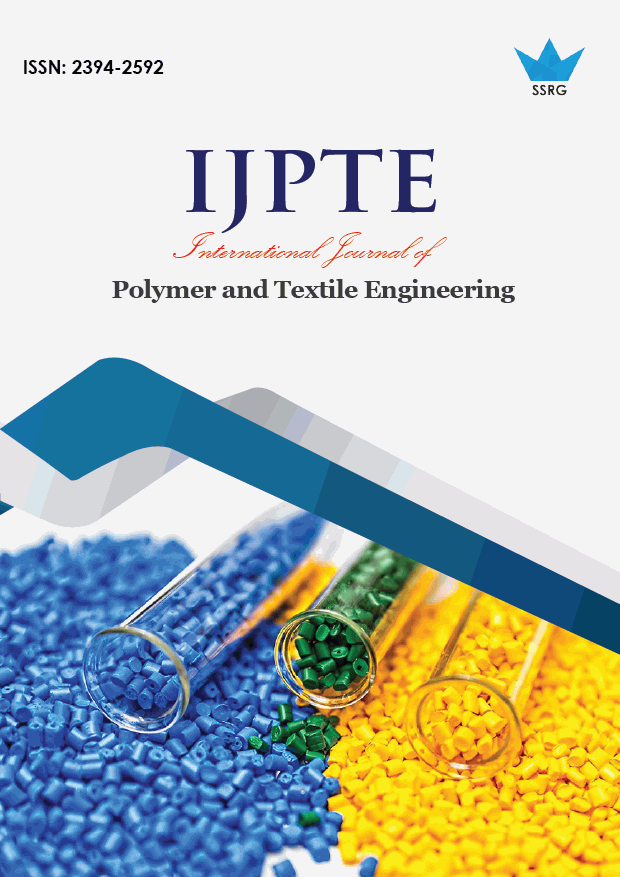Charcterisation of Banana Pseudostem Sap Used As a Mordant for Dying

| International Journal of Polymer and Textile Engineering |
| © 2015 by SSRG - IJPTE Journal |
| Volume 2 Issue 3 |
| Year of Publication : 2015 |
| Authors : Shyam Barhanpurkar, Alok Kumar, Roli Purwar |
How to Cite?
Shyam Barhanpurkar, Alok Kumar, Roli Purwar, "Charcterisation of Banana Pseudostem Sap Used As a Mordant for Dying," SSRG International Journal of Polymer and Textile Engineering, vol. 2, no. 3, pp. 1-7, 2015. Crossref, https://doi.org/10.14445/23942592/IJPTE-V2I5P101
Abstract:
Banana and banana parts serves as a unique ideal and low cost food source in developing countries. Where most of the populations depend upon for taking cheaper rate nutrition fruits. Banana sap consists of different chemical constituents like carbohydrates, cellulose, lignin, ash, colouring matter and portentous material. These constituents develop through the secondary metabolism of plant contain ISO paranoid, nitrogen and phenolic compounds of plants. In this research study banana pseudo stem sap has been taken for the fixation of natural dye and its chemical composition with qualitative chemical analysis has been observed. The dyeing method like a pilot study with pre mordanting, post mordanting and simultaneous mordanting process is used. In this article main focus on the determination on chemical composition of banana sap has been taken. For the dye fixation banana sap is containing tannin which has great properties for fixation of dye molecules. Natural dyes are well known for their poor fastness properties. So in this study banana sap here used as a mordent. The dyeing results are found quiet appreciable.
Keywords:
Banana pseudo stem sap, mordent, tannin, lignin, Dye fixation, mordanting process.
References:
1. Leslie, S.C., (1976): An Introduction to the Botany of Tropical Crops. 2nd Edn. Longman Group Limited London, pp: 153-15.
2. Akinyosoye, V.O., (1991): Tropical Agricultural. Macmillan Publishers Limited, Ibadan, pp: 65-68.
3. Ammayappan et. al., (2004): Natural Dye From Pseudostem Of Banana For Silk. Man-made Text India,47(6), 218-220
4. Cordeiro, N., Belgacem, M.N., Torres, I.C. and Moura, J.C.V.P. (2004) Chemical composition and pulping of banana pseudo-stems. Journal of Industrial Crop and
Products 19: 147-154.
5. Dixit, S., and Jahan, S., (2005): Colorfastness properties of Euphorbia continifolia leaves dye on silk fabric. Man-made Text India, 58(5), 252-254
6. Agarwal, R., Pruthi, N., and Singh (2007): Effect of Mordant on Printing with Marigold Flower Dye. Natural product Radiance, Vol. 6(4), pp.306-309
7. Adeel, S., Ali, S., Bhatti, I. A. And Zsila, F. (2009): Dyeing of Cotton Fabric Using Pomegranate (Punica granatum) Aqueous Extract. Asian J. Chem,. 21(5): 3493-3499.
8. Haslinda, W.H., Cheng, L.H., Chong, L.C. and Noor Aziah, A. A. (2009): Chemical composition and physiochemical properties of green banana (Musa acuminate X balbisiana Colla cv. Awak) flour. International Journal of Food Sciences and Nutrition 60(S4): 232-239.
9. Goodarzian, H and Ekrami, E. (2010): Extraction of Dye From Madder Plant (Rubia tinctorium) and Dyeing of wool.World Applied Sciences journal 9(4): 434-436
10. Haji, Aminoddin (2010): Functional Dyeing of Wool with Natural Dye Extracted From Berberis vulgaris Wood And Rumex hymenosepolus Root As Biomordant. Iran. J. Chem.
Chem. Eng. Vol. 29, No. 3
11. Mohapatra, D., Mishra, S. and Sutar, N. (2010): Banana and its by-product utilization: an overview. Scientific and Industrial Research 69: 323-329.
12. Grover, N.,and Patni, V.,(2011) : Extraction And Application Of Natural Dye Preparations From The Floral Parts Of Woodfordia fruticosa . Indian Journal of Natural
Products and Resources Vol. 2(4), pp 403-408
13. Akpabio, U.D., Udiong D.S. and Akpakpan A.E. (2012): The Physicochemical Characteristics Of Plantain (Musa Paradisiaca) And Banana (Musa Sapientum) Pseudostem
Wastes. Advances in Natural and Applied Sciences, 6(2):167-
14. Bose, S., and Nag, S.,(2012): Isolation Of Natural Dyes From The Flower Of Hibiscus Rosa-sinensis.Am. J. PharmTech Res.2(3) by the Exhaustion Process. FIBRES & TEXTILES in Eastern Europe 2011, Vol. 19, and No. 3 (86) pp. 94-99.
15. Deshpande, R., and Chaturvedi, A.,(2012): Colorant Potential Of Ricinus Communis L. On Silk And Cotton Cloth. Science Research Reporter 2(3):302-306
16. Mahale et.al.,(2003): Acalypha leaves for silk dyeing. Indian J Fibre Text Res, 28,86-89
17. Mathur et.al.,(2003): Neem Bark As Wool Colourant. Indian J Fibre Text Res, 28,94-99
18. Mongkholrattanasit, R., Krystufek, J.,Wiener, J., and Viková M., (2011): Dyeing, Fastness, and UV Protection Properties of Silk and Wool Fabrics Dyed with Eucalyptus Leaf Extract by the Exhaustion Process Fibers and Textiles, 19(3):, 94-99.

 10.14445/23942592/IJPTE-V2I5P101
10.14445/23942592/IJPTE-V2I5P101